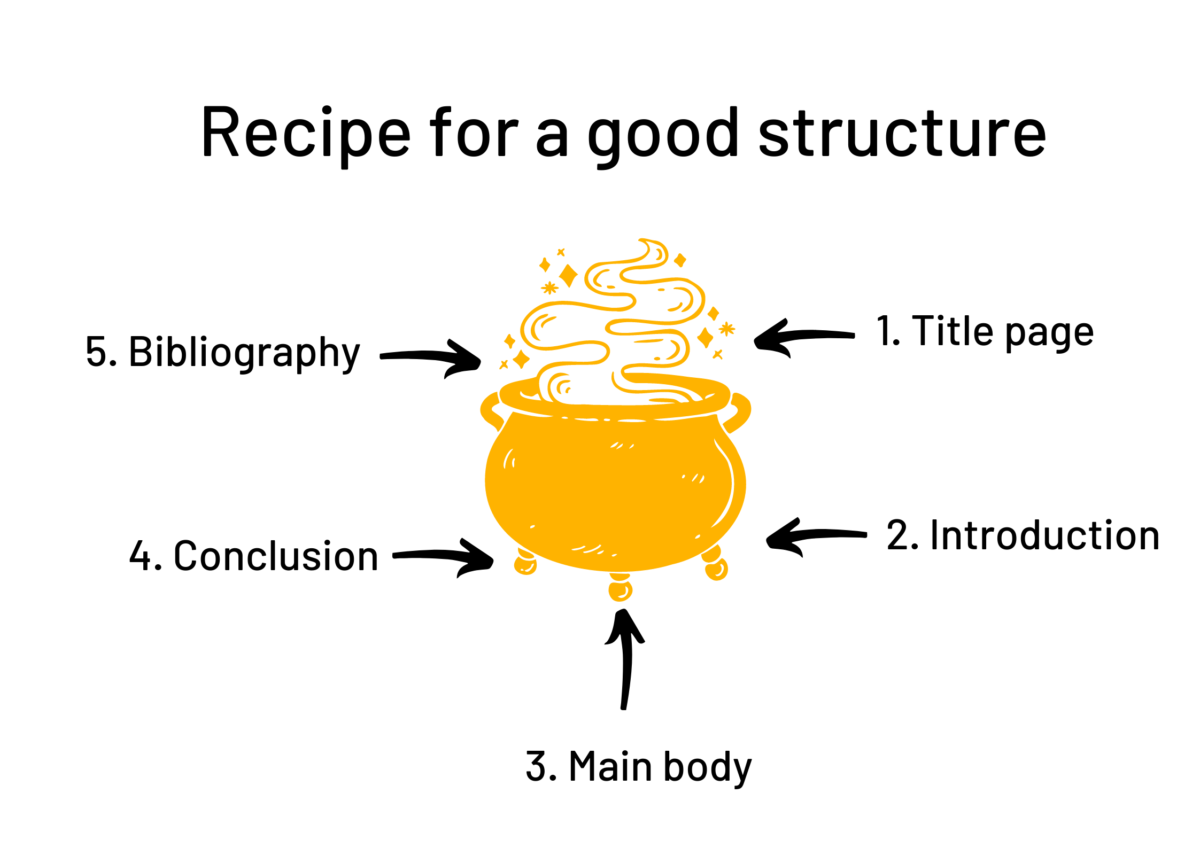- Keep it simple: Choose a clear structure for your paper.
- Structure helps the flow of your argument.
- Stick to the standards.
Why is structure important?
The structure of your paper builds the foundation of your argument. It helps you guide the readers from the introduction to the conclusion. More pragmatically, the structure provides checkpoints for your paper, thus helping you fill or reduce the word count. You also make sure that you get all the points for formalities, which often make up a substantial part of your grade.
In other words, the structure is a somewhat standardized framework for academic writing. By meeting the requirements set by your institution or the academic field you work in, you become a part of the discourse.
Different fields of research use different standards when it comes to academic writing. The biggest difference probably exists between papers written in science and in arts and humanities. Generally, you will find the following structure:
- Title page
- Abstract (if applicable)
- Table of contents (if applicable)
- Figures and tables (if applicable)
- Abbreviations (if applicable)
- Introduction
- Main body (including methodology, results, and discussion)
- Conclusion
- List of references OR bibliography (learn more about the difference in our tutorial on citation)
- Appendices (if applicable)
In sum, the essence of a well-structured paper contains a title page, an introduction, a main body, a conclusion, and a reference section. Of course, this is a very reduced representation of the general structure, and it might vary across disciplines. So, double-check the requirements given by your institution or field.
In the following, we’ll introduce the most important basics for the perfect structure of your paper.
What makes a good structure?
A good structure starts with the basics. By setting the stage for the argument you’re presenting, you ensure that readers understand the initial problem, aim, and methodology applied in your research. This is essential because otherwise, your research exists in the void.
A well-situated argument with a clear structure reads easily. Academic writing doesn’t have to be complicated, and the structure helps you do exactly that. Plus, it gives you a rough idea of how long each section should be, which helps you be concise in the right places.
Pro-tip: If you start writing your paper by structuring it – by choosing headings and determining the length of each section – you’ll create a clear direction for your argument. Having a clear idea of the flow of your paper helps you not get lost in the details.
A good structure makes a good argument.

What formalities are there?
There are several conventions when it comes to academic writing that you should always include in your paper:
- Title page: This single page contains important information pertinent to your paper, including your name, school, student number, course details, and the title of the piece of writing.
- Abstract: Not all papers need an abstract, but it is customary for longer pieces of work, scientific papers, or dissertations. An abstract presents a short summary of the research, including the most important findings.
- Dedication and Acknowledgements: Usually, you won’t need to include a dedication or acknowledgements in your paper, as they are customary for dissertations and other longer pieces of academic writing.
- Table of contents: This helps readers gain an initial overview of your research and allows them to find information easily. This might not be required for essay-type assignments.
- Appendices: Some studies work with databases or interviews. You might want to include such materials in your paper without it disturbing the flow of your argument. The appendix serves as a kind of storage unit for this information.
- Declaration of own work: Some universities require you to provide a written and signed declaration stating that all sources have been indicated properly. This is to avoid plagiarism.
- Gender disclaimer: Depending on the language of your paper, you might want to add a note on the use of gendered/gender-inclusive language.

- Don’t forget to check the requirements set by your institution!
- Don’t break your paper down into too many subsections and subheadings!
- Don’t mix the structure around!
Test yourself
Complete the following sentence: When writing your history assignment, you make sure to…
A. …start by situating your topic in the introduction.
B. …mention every important date regarding WWII in the introduction.
C. …citing a quote from Shakespeare.
The title page must include the following:
A. The name of the current president
B. Your passport photo
C. Your name
State whether the following is true or false: Every academic paper includes an introduction, a main body part, and a conclusion.
A. True
B. False
C. Kittens
You’re currently working on an assignment for your geography module. Which of the sections listed below are part of your paper?
A. Introduction, main body, conclusion, declaration of own work
B. A picture of your cat in the wild, title page, main body, list of references
C. Acknowledgements thanking your parents, neighbors, and favorite barista, table of contents, introduction, list of references, appendices
How does structure help your argumentation?
A. It makes your paper look organized.
B. It guides the reader from the basics to the conclusion of your argument.
C. It doesn’t.
Solutions:
A / C / A / A / B